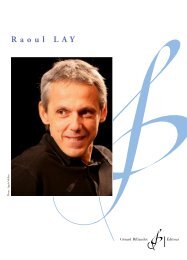Catalogue auteur de Jean-Michel Damase [ pdf - 200 Ko ] - Gérard ...
Catalogue auteur de Jean-Michel Damase [ pdf - 200 Ko ] - Gérard ...
Catalogue auteur de Jean-Michel Damase [ pdf - 200 Ko ] - Gérard ...
You also want an ePaper? Increase the reach of your titles
YUMPU automatically turns print PDFs into web optimized ePapers that Google loves.
His orchestration is full and colourful, but he favours chamber music, particularly<br />
for wind instruments (Quatre divertissements for flute and piano,<br />
Hommage à Klosé and 15 étu<strong>de</strong>s dans le style français for clarinet, Azur for saxophone<br />
and piano, Aspects for horn and piano, Prélu<strong>de</strong>, élégie et final for trombone<br />
and piano, Quatuor <strong>de</strong> flûtes, Suite pastorale for three flutes, etc.), small<br />
ensembles (Casino et lutheries for flute, harp and string quintet, Rondo,<br />
Guitare, Cavatine, etc.) and concertante pages (a Concertino for piano and<br />
string orchestra that he is particularly fond of, a Rhapsodie for flute and string<br />
orchestra) and also scores <strong>de</strong>signed for teaching (Scherzando for junior orchestra,<br />
Suite en sol for junior string orchestra, Cinq petits dialogues for marimba<br />
and harp or piano).<br />
Apart from chamber music ensembles, <strong>Damase</strong> has <strong>de</strong>voted himself to dramatic<br />
music. He wrote his first ballet for Roland Petit, La croqueuse <strong>de</strong> diamants<br />
(1950), then the Marquis <strong>de</strong> Cuevas - for whom he took up conducting<br />
- commissioned Piège <strong>de</strong> lumière (1952) from him. Along with Balance à<br />
trois (1955) and La Boucle (1957), this work forms a choreographic trilogy.<br />
His encounter with his neighbour <strong>Jean</strong> Anouilh led him to turn his attention<br />
to the theatre and lyrical art. "As I liked his drama," he recalls, "I finally asked<br />
him for permission to compose a lyrical work drawn from one of his plays.<br />
'What do you see in it?', he asked me. 'It's just a farce... What sort of music<br />
are you going to set it to? I can't see it myself! Start work, play me an act and<br />
I'll tell you if it's possible.' That's how I wrote Colombe (1956), then Euridyce<br />
(1972) and Madame <strong>de</strong> (1970), that he had adapted from Louise <strong>de</strong><br />
Vilmorin, and he asked me to handle the stage music for La petite Molière and<br />
Directeur <strong>de</strong> l'Opéra."<br />
Another lyrical work, La tendre Eléonore, an 'opéra bouffe' written to a Loys<br />
Masson libretto, was first performed on the 10th March 1962 at the<br />
Marseilles Opera. To this group of dramatic works should be ad<strong>de</strong>d the Onze<br />
Psaumes <strong>de</strong> David for solo baritone, choir and wind orchestra (1985).<br />
All this sums up his immediately accessible music, a music which <strong>Damase</strong><br />
himself ascribes to French tradition: "basically music that is cheerful and singing,<br />
but also enriched with a certain nostalgia and a little <strong>de</strong>pth." When<br />
asked why he has remained loyal to tonality, he laughingly replies: "I'm loyal<br />
by nature."<br />
6<br />
Bruno SERROU


![Catalogue auteur de Jean-Michel Damase [ pdf - 200 Ko ] - Gérard ...](https://img.yumpu.com/17009412/6/500x640/catalogue-auteur-de-jean-michel-damase-pdf-200-ko-gerard-.jpg)

![Catalogue auteur de Pierre-Max Dubois [ pdf - 240 Ko ] - Gérard ...](https://img.yumpu.com/17004372/1/182x260/catalogue-auteur-de-pierre-max-dubois-pdf-240-ko-gerard-.jpg?quality=85)
![Composer catalogue of André Jolivet [ pdf - 220 Kb ] - Gérard ...](https://img.yumpu.com/15199347/1/188x260/composer-catalogue-of-andre-jolivet-pdf-220-kb-gerard-.jpg?quality=85)